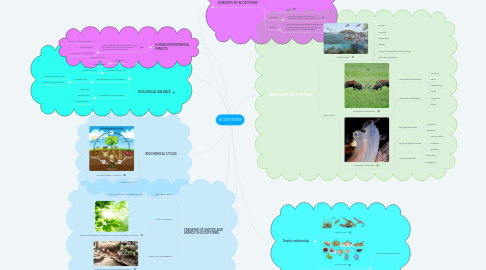
1. CONCEPTS OF ECOSYSTEMS
1.1. Types
1.2. Biocenosis
1.2.1. Set of organisms, that live and reproduce under certain conditions
1.3. Biotope
1.3.1. Means biological environment, and are the environmental conditions that occur in a certain way and in a defined place.
2. TRANSFER OF MATTER AND ENERGY IN ECOSYSTEMS
2.1. PRODUCERS
2.1.1. PHOTOSYNTHESIS AND RESPIRATION
2.2. CONSUMERS
2.2.1. There are three types of consumers: primary, secondary and tertiary.
2.3. DESCOMPOSERS
2.3.1. Decomposers are heterotrophic organisms.
3. BIOCHEMICAL CYCLES
3.1. NITROGEN CYCLE
3.2. CARBON CYCLE
4. ECOLOGICAL BALANCE
4.1. Production
4.1.1. Gross production
4.1.2. Net production
4.2. Ecological efficiency
4.2.1. Ten per cent rule
4.3. Net production of an ecosystem
4.3.1. Net estimation
4.3.1.1. Net primary production
4.3.1.2. Net secondary production
4.4. Productivity of an ecosystem
4.4.1. Productivity
4.4.2. Renewal rate
4.4.3. Renewal period
5. HUMAN ENVIROMENTAL IMPACTS
5.1. It is the alteration or modification caused by human action on the environment. Because all the actions of man.
5.1.1. The use of natural resources
5.1.2. Contamination
5.1.3. Occupation of the territory
6. ABIOTIC AND BIOTIC FACTORS
6.1. Abiotic factors
6.1.1. Sunlight
6.1.2. Humidity
6.1.3. Temperature
6.1.4. Density
6.1.5. Chemical composition of the medium
6.1.6. Substrate composition
6.2. Biotic factors
6.2.1. Intranspecific relationship
6.2.1.1. Competitive relationships
6.2.1.1.1. Territorial
6.2.1.1.2. Social
6.2.1.1.3. Reproductive
6.2.1.2. Associative relationships
6.2.1.2.1. Family
6.2.1.2.2. Gregarious
6.2.1.2.3. Castes
6.2.2. Interspecific relationship
6.2.2.1. Both species benefit
6.2.2.1.1. Mutualism
6.2.2.1.2. Symbiosis
6.2.2.2. Only one species benefit
6.2.2.2.1. Commensalism
6.2.2.2.2. Predation
6.2.2.2.3. Parasitism
6.2.2.3. No species benefit
6.2.2.3.1. Amensalism
6.2.2.3.2. Competition
7. Trophic relationship
7.1. Trophic chains
7.2. Tropchic web
7.2.1. Variety of ecological niches
